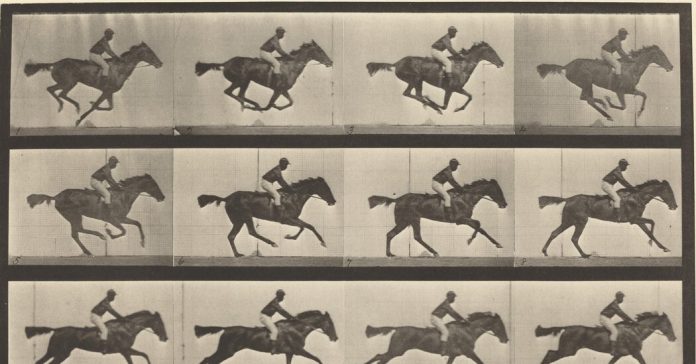Close to the start of “Nope,” Emerald (Keke Palmer), who together with her brother, Otis Jr. (Daniel Kaluuya), runs an animal-wrangling service for Hollywood shoots, delivers a pitch on a set. (In case you’ve seen the trailer, you’ve heard the abridged model.)
She cites a milestone within the improvement of cinema: a well-known collection of sequential images from the nineteenth century depicting a horse in movement. Emerald means that the crew members she is addressing will know the identify of the person who captured these photographs, the photographer Eadweard Muybridge. However they received’t be capable to identify the jockey driving the horse. That pioneering actor and stunt man, Emerald says, was her great-great-great grandfather.
That final half is a little bit of invention by the writer-director, Jordan Peele. His level is that the id of the Black horse rider might be unknown, and that from the beginning of flicks, the digicam — with its energy to see — has additionally left sure individuals, and sure tales, unseen.
Muybridge is the guiding spirit of “Nope,” wherein the siblings, together with an electronics-store worker (Brandon Perea) and a cinematographer (Michael Wincott), attempt to snap a photograph of an elusive extraterrestrial presence. They’re trying to seize an not possible shot, with a topic that, like Muybridge’s horses, is just too quick to pin down. And because the U.F.O. scrambles all of the electrical energy in its path, they should innovate with analog expertise, as Muybridge did. (Muybridge was additionally a chronicler of the American West.)
However the precise improvement of Muybridge’s experiments — and the query of whether or not the rider’s id is really unknown — is difficult.
In a preface to his e book “Animals in Movement,” Muybridge recalled that his experiments in photographing motion started in 1872, when he sought to reply the query of whether or not, at any level in a horse’s stride, all 4 ft concurrently left the bottom. By his personal account, he was capable of seize silhouettes of 4 airborne ft with roughly peculiar photographic gear at a racetrack in Sacramento. However the effort ignited his want to make one thing extra cinematic, as we’d now consider it: photographs photographed in speedy succession at outlined intervals of time, the higher to grasp animal motion typically.
Within the late 1870s, in Palo Alto, Calif., on the farm of the state’s former governor (and future senator and college founder) Leland Stanford, Muybridge performed additional experiments, growing a system wherein rigorously arrayed cameras had been related to wires {that a} horse’s travels alongside a monitor may journey. (Through the intervening years, Muybridge would stand trial for the homicide of his spouse’s lover and be acquitted on the grounds that it was justifiable murder — however let’s go away that for a future Peele movie.)
By Muybridge’s recollection, the collection of images that grew to become often known as “The Horse in Movement” was first printed in 1878. The subsequent yr, he would start holding shows that put his sequential images — or, technically, inventive reproductions of them — in movement, utilizing a tool he referred to as the zoopraxiscope, a forerunner of the movie projector. And so far as “The Horse in Movement” is anxious, some (although not all) of the stills held on the Library of Congress point out the names of the riders.
However these images will not be the pictures proven in “Nope.” The Muybridge works within the film, with the unnamed rider, are from “Plate Quantity 626,” a part of a later collection of locomotion research that Muybridge started on the College of Pennsylvania in 1884 and printed in 1887.
By then, he had entry to a brand new course of, dry-plate images, that was extra delicate to gentle and element. At Penn, he undertook what he described as a “extra systematic and complete investigation,” photographing all kinds of animals and women and men of all sizes and shapes, typically within the nude. The purpose was to see the physique in movement, in any case.
There have been even “horses with bare riders, female and male,” because the narrator notes in “Eadweard Muybridge, Zoopraxographer” (1975), an early documentary from Thom Andersen (“Los Angeles Performs Itself”) that’s important viewing for anybody who desires to study extra concerning the scope of Muybridge’s ambitions and to see his images dropped at life. (The movie is streaming on Mubi.)
The rider featured in “Nope” occurs to be clothed, and a broadcast model of these photographs signifies that the images had been meant as an instance a gallop. The caption data says the horse was a thoroughbred mare named Annie. It additionally signifies varied occasions and measurements associated to her stride.
However the identify of the rider shouldn’t be talked about. In keeping with Andersen’s movie, that’s typical: Whereas Muybridge’s catalog “provides the names of all of the horses, mules and canine,” the voice-over says, Muybridge typically “identifies his human fashions solely by quantity.”
So whereas the pictures in “Nope” aren’t, strictly talking, the horse experience that gave delivery to cinema, the pioneering actor, animal wrangler and stunt man proven in them most likely is unknown. He sits alongside the numerous different male athletes, girls mimicking housekeeping and kids in Muybridge’s oeuvre: an nameless solid of characters from early movie historical past.


